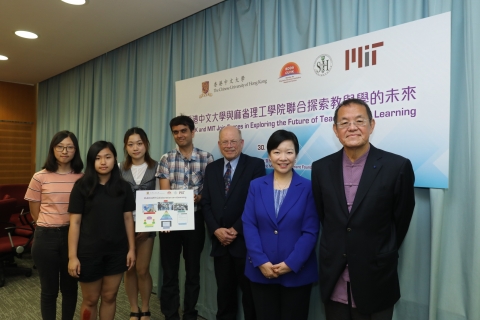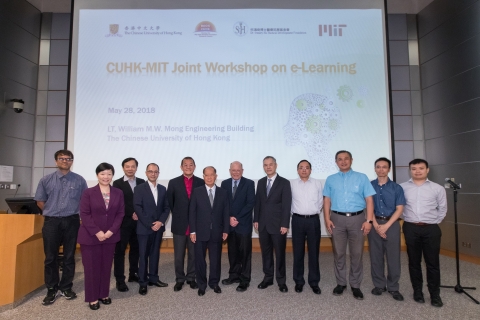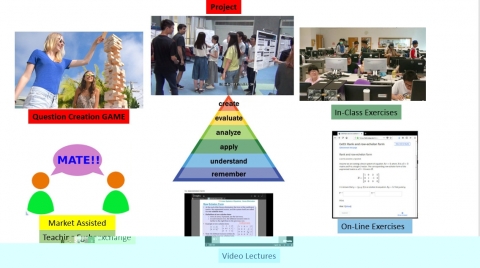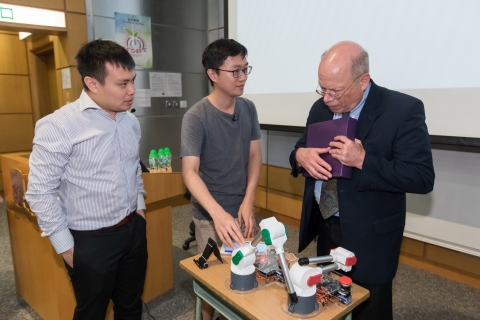The Faculty of Engineering, together with the Faculty of Education and Faculty of Social Science, is collaborating with the Massachusetts Institute of Technology to explore using cutting-edge technology to improve teaching and learning, especially through understanding best practices for flipped classroom teaching via eLearning technologies. Experiments are ongoing with innovative technologies that enhance educational strategies, measure outcomes and understand the impact of individualised learning trajectories. This collaborative research project with MIT is sponsored by the Dr. Stanley Ho Medical Development Foundation through the CUHK Stanley Ho Big Data Decision Analytics Research Centre, which is co-directed by Professor Joseph Sung, Mok Hing Yiu Professor of Medicine and Professor Helen Meng, Patrick Huen Wing Ming Professor of Systems Engineering & Engineering. In the recent CUHK-MIT eLearning Workshop, the research findings thus far presented have been based on investigations in eLearning with flipped classroom teaching led by Professor Sidharth Jaggi in an elite freshmen engineering mathematics class at CUHK, as well as a computer architecture class led by Dr. Chris Terman at MIT. This research effort involves inter-disciplinary collaboration across three CUHK faculties (the Faculty of Education, the Faculty of Engineering and the Faculty of Social Science) and the faculty at the Computer Science and Artificial Intelligence Laboratory (CSAIL) at MIT, to investigate pedagogical efficacies and social dynamics in teaching and learning through data-driven analyses. The aim is to find ways to help students reach high levels of understanding of the subject matter. Flipped classroom is a novel educational paradigm enabled by technology. Basic content delivery/skills acquisition is conducted at home with videos and online exercises. The main activity in the classroom is to deepen skills and mastery with peer-to-peer (P2P) teaching and learning that encourages creativity and personal experience. More interestingly, the research findings illustrate that knowledge can flow from social interactions. Dr. Chris Terman, Senior Lecturer and former Co-Director of CSAIL, MIT said, ‘It’s great to have the opportunity for CUHK and MIT to share experiences of how best to use online materials to improve on-campus learning outcomes. There is a slow revolution underway in how best to teach STEM subjects at the university level, one that will benefit both students and faculty. Many thanks to the Dr. Stanley Ho Medical Foundation for sponsoring this workshop and the CUHK-MIT collaboration, which is helping to connect the communities of practice at these two universities.’ In the collaboration, some undergraduate courses in engineering mathematics at CUHK and computer architecture at MIT have adopted the Market-Assisted Teaching Exchange (MATE) System developed by Professor Sidharth Jaggi, Associate Professor, Department of Information Engineering of CUHK. In 2017, Professor Jaggi incorporated the concept of a knowledge exchange market into an interactive teaching and learning model, the MATE system, and applied it in the freshmen engineering mathematics elite course he teaches. Students are requested to study and research before class, advertise their level of understanding of the concepts of the class, use their strengths to help others, and then are given coupons (worth class points) in return. In the other way around, they can give out coupons to those helping them understand the concepts. This P2P learning system is warmly welcomed by the students because it can provide a wide variety of personalised help. The learning data analytics indicates that the students’ academic progress with this teaching and learning pedagogy is better than with the traditional teaching and learning mode. Some of the techniques used are indicated in the graphics attached. Professor Jaggi said, ‘As technology rapidly integrates into and changes society, our methods of educating current and future generations must also change, not just in terms of what we teach them, but also how we teach it. Integrating interactive e-learning techniques into education can lead to better learning outcomes than traditional teaching does. This project investigates multiple innovative teaching and learning techniques, and helps re-imagine what classrooms of the future can look like.’ Professor Helen Meng, Patrick Huen Wing Ming Professor of Systems Engineering & Engineering Management and Co-Director of the Stanley Ho Big Data Decision Analytics Research Centre, CUHK concluded, ‘Our research focuses on the use of data analytics for comparative pedagogical efficacies of online versus classroom teaching and learning, to derive unique and deep insights into individual and group learning processes.’ This article was originally published on CUHK Communications and Public Relations Office website. |
|





